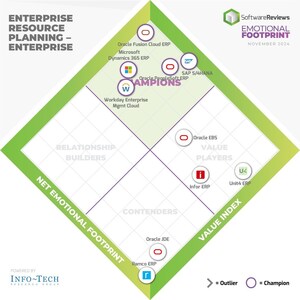Asking customers for feedback and then doing nothing with it is worse than not asking for feedback at all.
TORONTO, Dec. 19, 2022 /PRNewswire/ - Many service desks continue to rely solely on traditional metrics, which results in an increasing number of dissatisfied users and leaves IT leaders with a lack of information to inform and prioritize improvements. To help IT ask the right questions to effectively respond to user feedback and drive up the customer satisfaction score (CSAT), global IT research and advisory firm Info-Tech Research Group has published a new industry blueprint, Take Action on Service Desk Customer Feedback.
Info-Tech's research shows that IT service desks often rely on metrics like time to respond or percentage of service-level agreements (SLAs) met instead of measuring customer satisfaction with the service they receive. Although many service desks use transactional ticket surveys, these can be ineffective due to low response rates or little to no action on the feedback received. In many organizations where no mechanism exists to capture perceptions and behaviors, this can cause increased user dissatisfaction, evidenced through such examples as shadow IT or a large number of users who avoid the service desk and directly go to their favorite technician.
"Feedback is important because traditional service desk metrics can only tell so much," says Natalie Sansone, research director at Info-Tech Research Group. "We often see what's called the 'watermelon effect.' This is where metrics appear 'green,' but under the surface they are 'red' because customers are dissatisfied for reasons unmeasured by standard internal IT metrics. Customer satisfaction should always be the goal of service delivery, and directly measuring satisfaction in addition to traditional metrics will help IT leaders get a clearer picture of strengths, weaknesses, and where to prioritize improvements."
The firm's studies further indicate that some of the main obstacles IT leaders face include not knowing how to design user feedback survey questions or not having a mechanism to survey users. Even if customer satisfaction surveys are in place, often nothing is done with the results because service desk leaders either do not understand the value of analyzing the data or do not know how to analyze the data. With IT lacking the resources or time to take accountability for or to act on the feedback program, it is time for organizations to take a different approach.
"It is not as simple as asking customers if they are satisfied with their tickets; there are two steps necessary for success," says Emily Sugerman, research analyst at Info-Tech Research Group. "The first is collecting feedback, which should be done purposefully, with clear goals in mind, in order to maximize the response rate and value of responses received. The second – and most critical – is acting on that feedback to inform improvements and communicate those improvements. Doing so will not only improve the service desk, increasing satisfaction through better service delivery, but also make the customers feel heard and valued, which alone increases satisfaction."
Based on the timely research, the firm recommends that IT leaders consider the following methodology for measuring and acting on service desk customer feedback:
- Understand how to measure customer satisfaction: Understand the main types of customer satisfaction surveys, principles for survey design, and best practices for surveying users.
- Design and implement transactional surveys: Learn why and how to design a simple survey to assess satisfaction with individual service desk transactions (tickets) and a methodology for survey delivery that will improve response rates.
- Design and implement relationship surveys: Understand why and how to design a survey to assess overall satisfaction with the service desk across the organization.
- Analyze and act on feedback: Measure and analyze the results of both surveys and build a plan to act on both positive and negative feedback and communicate the results with the organization.
According to Info-Tech's research, it can be worse to ask customers for feedback and not act on it than to not ask for feedback at all, as customers may become more dissatisfied if they take the time to provide value and then see nothing done with it.
To learn more, download the complete Take Action on Service Desk Customer Feedback blueprint.
For more about Info-Tech Research Group or to access the latest research, visit infotech.com and connect via LinkedIn and Twitter.
About Info-Tech Research Group
Info-Tech Research Group is one of the world's leading information technology research and advisory firms, proudly serving over 30,000 IT professionals. The company produces unbiased and highly relevant research to help CIOs and IT leaders make strategic, timely, and well-informed decisions. For 25 years, Info-Tech has partnered closely with IT teams to provide them with everything they need, from actionable tools to analyst guidance, ensuring they deliver measurable results for their organizations.
Media professionals can register for unrestricted access to research across IT, HR, and software and over 200 IT and Industry analysts through the ITRG Media Insiders Program. To gain access, contact [email protected].
SOURCE Info-Tech Research Group

WANT YOUR COMPANY'S NEWS FEATURED ON PRNEWSWIRE.COM?
Newsrooms &
Influencers
Digital Media
Outlets
Journalists
Opted In






Share this article